As a child of the ‘60s, I grew up in an era when anyone looking to put a little fun in their driving had really just two choices: a Detroit muscle car or a British sports car. Either way, you knew you’d be spending plenty of weekends tinkering and tweaking to keep your wheels running. Friends with a Triumph Spitfire or MGB often would have two, one serving as a parts donor.
No surprise, then, that by the late 1980s those British 2-seaters had largely vanished from our shores, leaving a gap that was unexpectedly filled by a quirky little Japanese car company named Mazda. Best known for the rotary-powered RX-7 and an assortment of little economy cars, the Hiroshima-based automaker took a bold chance on trying something completely different, dubbing its new offering the Miata.
These days, It’s known by the slightly longer name, the MX-5 Miata, but whatever you choose to call it, our first drive in the all-new 2016 roadster brings to mind the way we described the first Miata a quarter-century ago: the best British sports car the Japanese have ever built.
Loyal fans, of which there are plenty, will have yet another name for the 2016 Mazda Miata, the ND, shorthand for the fourth-generation roadster. By pure luck we happened to spot someone driving the original NA model as we put the new model through its paces. Flagging him over, we got the chance to compare the two.
From a pure design standpoint, the 2016 Miata is far closer to the original than the NB and NC, or second and third-generation models. It’s got less of the almost cartoonish bulges of recent years. Surprisingly, it’s also a couple inches shorter – thanks to the use of new LED headlamps that reduce the length of the nose — though a wee bit wider. You also sit slightly lower and closer to the center of gravity.
(Toyota planning radical sports car concept for Tokyo Motor Show debut. Click Here for more.)
There are some very modern elements with the 2016 Miata that pick up on the design language we’ve seen in other recent offerings. The original roadster’s grille gave it a guppy-like appearance, the large new grille is more shark-like. Those LED lamps, meanwhile, shine in place of the long-gone pop-ups. There’s more curve to the sheet metal, with subtle creases flowing off the nose into bolder front and rear wheel wells. And the new car’s 16- and 17-inch wheels – depending on model – make the original look like it’s riding on roller skates.
Despite the changes, there’s an elegant simplicity that carries over from the original. Aficionados will know it’s a Mazda Miata at first glance.
That’s true inside, though we found some of the most significant changes in the interior.
There’s probably a wee bit more hard plastic than we’d like but the execution is far more attractive than with any prior-generation Miata. The gauge cluster is especially handsome yet, in keeping with Miata’s ethos, simple and easy to grasp. The rotary climate control knobs are an improvement, as is the little notch in center console for storing a smartphone. It’s all in the details, and one nice touch was moving the parking brake to the passenger side of the console, out of the way as you work the delightful 6-speed stick.
Perhaps the most controversial detail is the LCD screen that sits atop the center console. It’s a reality these days, no matter how much we’d like to go back to basics, though. Kudos to Mazda for also giving us a rotary controller to operate the various infotainment features. It makes it a lot easier to keep your eyes on the road when you’re flogging the Miata around some tight and twisty roads.
To find them, we quite literally went to Hell and back. Hell, Michigan, that is, a small community north of Ann Arbor that seems to exist primarily to serve as the butt of bad jokes. But it’s also the gateway to some of the best driver’s roads in Michigan.
The goal was, if anything, to provide even more fun than the original NA Miata, stressed Dave Coleman, a senior engineer on the project.
To start with, Mazda based the new roadster on its SkyActiv philosophy. And here we digress. While many folks think SkyActiv is a type of engine, it’s actually a Zen-like approach to car design that takes in virtually every detail. A key focus is on weight, Mazda even switching from five to four lugnuts with the new car. “The goal,” explained Coleman, “was to avoid that generational creep” that we’ve seen on so many vehicles over the year, each new model getting heavier than before. The new Miata actually loses 150 pounds compared to the outgoing MX-5 NC edition.
(Why have more than 30 million vehicles been recalled for faulty Takata airbags? Congressional committee hopes to find out. Click Here for the latest.)
That’s one reason potential buyers shouldn’t get freaked out when they hear that the 2016 roadster actually delivers less horsepower than before. The new 2.0-liter package makes 155-hp, down from 167. But torque climbs to 148 pound-feet from the old model’s 140.
What we really care about is the power-to-weight ratio, which is notably improved. Add the fact that the new inline-four delivers its power in the RPM range where you’ll actually use it. Preliminary tests by a variety of our colleagues suggest Mazda has shaved about a second off the NC model’s 0 to 60 times – which puts it in the high five to low six second range.
At the same time, fuel economy makes a major jump, to 27 City, 36 Highway with the 6-speed automatic, and 37/34 with the 6-speed stick. The 2015 Miata got 22 City and 28 Highway with either transmission.
One of the other neat touches with the new Miata was the attention Mazda engineers paid to getting the sound of the engine just right. With the original, a quarter century ago, they studied close to 100 different exhaust notes, tuning the NA’s to sound just right. The new roadster adds an audio feedback tube that actually pipes some engine noise back into the passenger compartment.
Maybe that’s one reason the 2016 Mazda Miata feels faster than its number would suggest. Another reason: its quick and intuitive throttle response. The pedal feels like it’s responding to your thoughts, rather than the push of your foot.
We didn’t have a chance to test the automatic, yet, but from a pure thrill factor, it’s hard to imagine wanting anything but the manual gearbox. Here’s where the 2016 Mazda Miata more than lives up to our memories of the original. The clutch is weighted just right, and shifts are short, crisp and precise.
But it’s what the Miata does when you find those twisty roads that really delivers that Zoom-Zoom feeling Mazda has long bragged about. The new car’s double-wishbone suspension, low seating and lighter weight give you a delightfully on-rails sort of feeling. There’s a bit of body roll, but it enhances the sense of cornering. This is, by the way, the first Miata to go with electric power-assist steering, and we can only wish others had their E-PAS systems so well-tuned.
For those who keep up on the auto industry’s inside news, Mazda technically developed the new Miata in a joint venture with Fiat Chrysler. The latter maker will come to market with its own version next year. But Mazda officials are quick to stress that FCA has zip-nada-zilch input in the development of the MX-5’s basic dynamics. And one ride will tell you this is a true Miata.
(Mazda or Fiat or Toyota? Alliances make it hard to tell whose car you’re really buying. Click Here for more.)
The new car is a bit more expensive than the old NC model, but you get a lot more features for your money with the 2016 Mazda Miata. The maker has, for one thing, simplified the ordering process. You essentially have four versions – and a bunch of colors – to choose from.
The base Sport starts at $24,915 plus $820 for delivery charges. The Miata Club comes in at $28,600, though there’s also a track-ready package, including such niceties as Brembo brakes and a stiffer suspension, that hits $32,000. The loaded Club – which gets features like navigation – comes in at $30,065. Oh, and to put this all into perspective, the original 1990 model cost $13,800 – with pretty much nothing but air in its tires.
No, it’s not a Porsche Boxster, but for a fraction of the cost you get most of the handling and thrills. I had a chance to drive the Alfa Romeo 4C down the same roads a few days later and while the Italian job was a bit quicker and delivered a more hearty rumble to its exhaust, it would be hard to justify the extra cash.
Sadly, in recent years, the Miata has developed something of a reputation as a hairdresser’s car. That’s too bad. Why should hair stylists have all the fun? The 2016 Mazda Miata is a car for anyone who thinks driving is about more than just getting from Point A to Point B. Somehow, Mazda has found a way to move the MX-5 a big step forward while capturing the soul of that very special machine it created a quarter century ago.

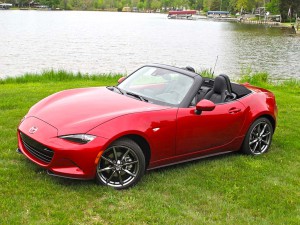
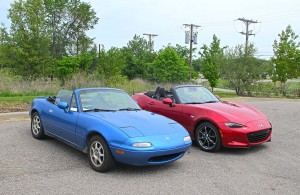

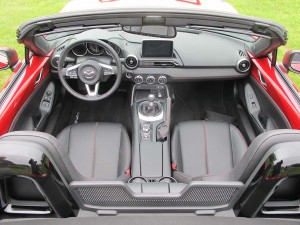
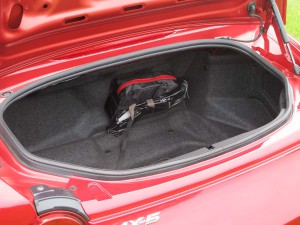


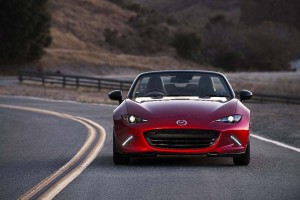
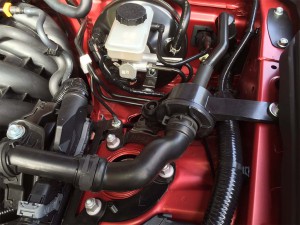
I’m really excited for the 2016 MX-5. I’ve covered it myself and have been avidly reading all the reviews and road tests I can. One of my first experiences as a child with cars was my father taking me to see a first generation Miata. I hope to be able to do the same with my son soon.